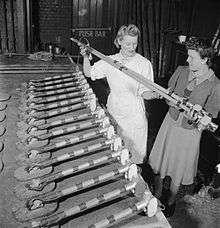Polish mine detector
The Mine detector (Polish) Mark I (Polish: wykrywacz min) was a metal detector for landmines developed during World War II. Initial work on the design had started in Poland but after the invasion of Poland by the Germans in 1939, and then the Fall of France in 1940, it was not until the winter of 1941–1942 that work was completed by Polish lieutenant Józef Kosacki.[1][2]


History
In the pre-war period the Department of Artillery of Poland's Ministry of National Defence ordered the construction of a device that could be helpful in locating duds on artillery training grounds. The instrument was designed by the AVA Wytwórnia Radiotechniczna, but its implementation was prevented by the German invasion of Poland. Following the fall of Poland and the transfer of Polish HQ to France, work restarted on the device, this time intended as a mine detector. Little is known of this stage of construction as the work was stopped by the Battle of France and the need to evacuate the Polish personnel to Great Britain.
There in late 1941 Lieutenant Józef Kosacki devised a final version, based partially on the earlier designs. His invention was not patented; he gave it as a gift to the British Army. He was given a letter of thanks from the King for this act. His design was accepted and 500 mine detectors were immediately sent to El Alamein where they doubled the speed of the British Eighth Army.[3][4] During the war more than 100,000 of this type were produced, together with several hundred thousands of further developments of the mine detector (Mk. II, Mk. III and Mk IV). The detector was used later during the Allied invasion of Sicily, the Allied invasion of Italy and the Invasion of Normandy. This type of detector was used by the British Army until 1995.
An attempt was made to mount a version of the mine detector on a vehicle so that sappers would be less vulnerable. To this end "Lulu" (on a Sherman tank) and subsequently "Bantu" (on a Staghound armoured car) were developed. The detector mechanism was in non-metallic rollers on arms held away from the vehicle. When the roller passed over a mine, or a similar piece of metal, the roller it was under was indicated in the vehicle. Prototypes were built but never tried in combat.[5]
Design
The Polish detector had two coils, one of which was connected to an oscillator which generated an oscillating current of an acoustic frequency. The other coil was connected to an amplifier and a headphone. When the coils came into proximity to a metallic object the balance between the coils was upset and the headphone reported a signal. The equipment weighed just under 30 pounds [14 kilograms] and could be operated by one man. The Polish detector saw service throughout the war and the Mark 4c version was still used by the British Army until 1995.
— Mike Croll, The History of Landmines
Ethnic joke
There is a long history of an ethnic joke whose punch line is that Polish people stamp their feet on the ground to detect mines, which is ironic since the real mine detector was designed by a Pole. Media mogul and billionaire Ted Turner once told such a joke. Mr. Turner made his version of the joke during a speech to the National Family Planning and Reproductive Association in Washington in 1999. Turner apologized to the Polish Foreign Ministry saying he regretted his comments.[6]
Notes
- Maslen, Stuart (2001). Anti-personnel mines under humanitarian law : a view from the vanishing point. Intersentia. pp. 126–127. ISBN 9789050951890.
- Hammond, Bryn (2012). El Alamein : the battle that turned the tide of the second World War. Osprey Pub. ISBN 9781780964539.
The first, and most important, was a reliable portable mine detector, of which the most noted example was invented by a Polish officer, Józef Stanisław Kosacki.
- "Detector Spots Buried Mines". Popular Science, May 1943.
- F. Majdalany The Battle of El Alamein: Fortress in the Sand 2003-p 86 "The new Polish mine detector (invented by a Polish officer serving in Britain) was making its debut in this battle, 500 of them having been rushed out to Eighth Army in time for Alamein, but some were faulty and many became damaged in ."
- Fletcher, The Universal Tank 1993 HMSO 0 11 290534 X pp 94–95.
- World: Europe Ted Turner says sorry, BBC News
References
- "The History of Landmines" by Mike Croll published in Great Britain in 1998 by Leo Cooper, Pen & Sword Books Ltd. ISBN 0-85052-628-0
- The Polish Contribution to The Ultimate Allied Victory in The Second World War Tadeusz Modelski, Worthing, England 1986, Page 221
- Time Magazine/Canadian Edition, March 8, 1999, page 18
- Mieczysław Borchólski "Z saperami generała Maczka", MON 1990, ISBN 83-11-07794-0